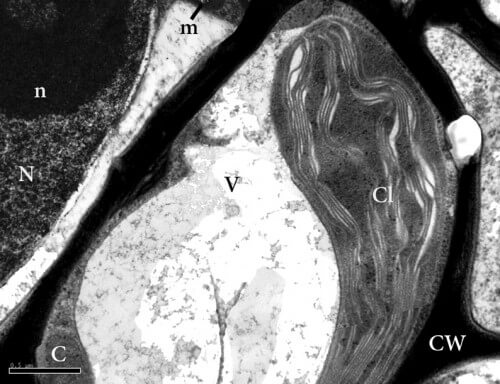The new findings provide essential information on the control of photosynthesis, and the ways in which plants adapt to the changes in light intensity that occur during the day.

The woman in the picture has a magnificent mane of hair, partially covering her naked body. This is not a recently discovered unknown work of art, but part of a plant cell, magnified more than 20,000 times.
The image was produced as part of a study by Prof. Ziv Reich and his group members, from the Department of Biological Chemistry at the Weizmann Institute of Science, together with Prof. Helmut Kirchenoff from the University of Washington, USA. The "hair" is actually a system of small, flat bubbles called thylakoids, found in the chloroplast of the plant. These bubbles contain the system that performs the main stages of photosynthesis - a process in which plants, algae, and certain bacteria use sunlight to produce chemical energy, and by the way, they also produce most of the oxygen found in the Earth's atmosphere. In an article published in the scientific journal "Records of the Academy of Sciences of the USA" (PNAS), the scientists report that they discovered why the "woman's hair" is so rich: the thickness of the space inside the thylakoids, called the lumen, almost doubles when the leaf is exposed to light.
The expansion of the lumen helps photosynthesis: it increases the space in which the pulsation (diffusion) of the protein responsible for the transfer of electrons takes place - an essential step in photosynthesis. These electrons are used to turn carbon dioxide into sugars, and their transfer is needed for the formation of the ATP molecule: the cell's main energy molecule. In addition, the expansion of the lumen enables repairs in the proteins of photosynthesis, because it helps their decomposition and transformation.

When darkness falls, the lumen contracts, thus limiting the movement of proteins. The contraction is probably required to prevent damage that may be caused to the photosynthetic system at sunrise, or when the light intensity increases suddenly - for example, following the movement of clouds. When the light is intensified all at once, the gradually expanding lumen ensures that the rate of electron transfer does not increase too quickly - something that could damage a key protein in the electron transfer chain.
These findings disprove the long-standing belief that the lumen in thylakoids shrinks in light. The source of explanation is the limitations of research methods in the early 70s of the last century. The new research, on the other hand, was done using advanced methods: the leaves of the plant were studied under an electron microscope, after quick freezing using liquid nitrogen, under extremely high pressure conditions. The frozen leaf is cut into thin layers, the thickness of which does not exceed a few tens of nanometers (billionths of a meter).
The new findings provide essential information on the control of photosynthesis, and the ways in which plants adapt to the changes in light intensity that occur during the day.
Chris Hall, Magnus Wood and Dr. Miroslava Hirbstova from Washington University participated in the study, as well as Oni Tzbari, Dr. Rinat Nebo and Dr. Dana Harubi from the Department of Biological Chemistry, and Dr. Eyal Shimoni from the Electron Microscopy Unit at the Weizmann Institute.

One response
What is amazing is that all this is a result of natural selection